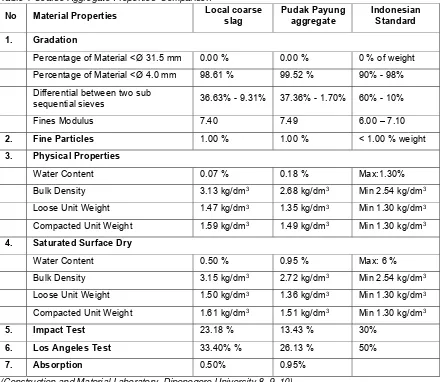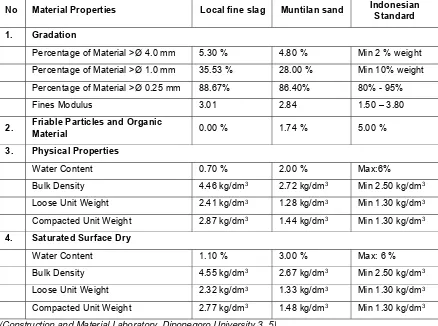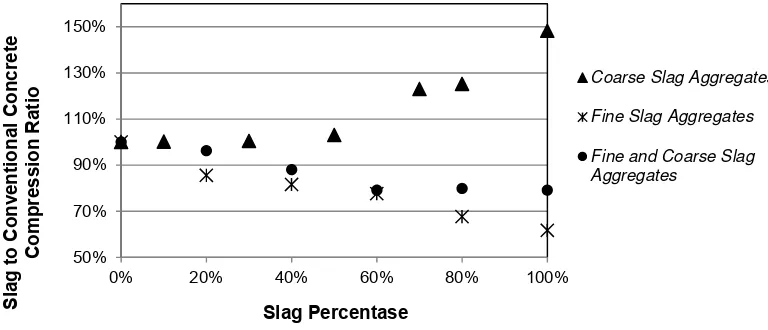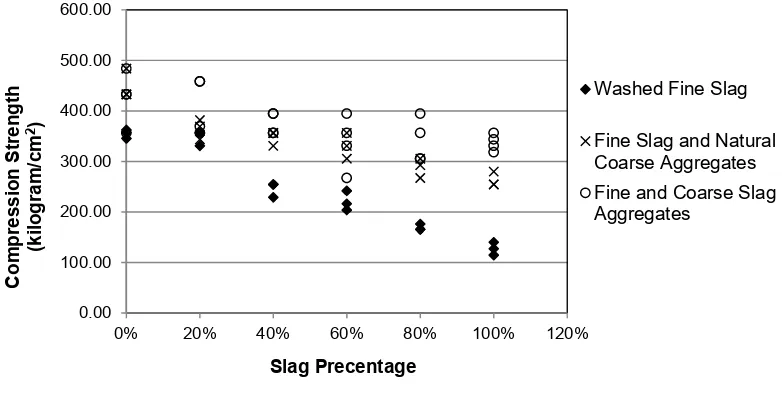THE STUDY OF CONCRETE WITH INDUSTRIAL STEEL-SLAG
AGGREGATES BASED ON THE SUBSTITUTION METHOD
Han Aylie, Diponegoro University, Indonesia Sri Tudjono, Diponegoro University, Indonesia
Abstract
Slag is a steel-industry-waste categorized as potential environmentally harmful,
containing heavy metals such as
Arsenic (As), Lead (Pb),
Chromium (Cr), Cuprum
(Cu)
and
Zinc (Zn).
A major Steel Plant in Semarang, Indonesia produces steel -
slag that is suspected of polluting soil and groundwater. In this study attempts have
been made to utilize this
slag-waste
as substitute for the aggregates used in
concrete. Since in hardened concrete the slag will be concealed totally by the
cement paste, it was hoped that the environmental impact can be controlled.
The investigation was based on the substitution method whereas the coarse as
well as the fine aggregates are replaced with slag. The research covers a range of
concrete’ strengths and the percentage of slag substitute were set as variable.
The study demonstrated that the
compression-strength-to-conventional-concrete
ratio increases, as the coarse slag content ascends. However, the
addition of fine
slag
will decrease the compression strength significantly. From the results it was
also proven that with a 100% of slag substitution the
heavy-metal leaching
concentration rate
is below the assigned border mandated by the
Department of
Industry
regulations and supports the International Atomic Energy Agency margins.
Keywords: Slag, Concrete, Compression Strength, Coarse and Fine Aggregates
1. Introduction.
Concrete has been the most chosen material for Indonesian’s building constructions since the components, sand, gravel and cement are easily accessible while mixing and placing does not require very highly skilled labor. Since National programs has placed the construction of civil works as one of their priorities, the need for natural sand and gravel has risen, resulting in cutting and dredging of mountain sites and rivers. On the other hand production at steel plants has increased due to the demand in reinforcing-steel. The plants produce coarse and fine slag categorized as environmentally hazardous as a site material [1, 2].
By performing a cement solidification process, slag will be bound by the cement past and therefore reducing negative environmental aspects. Further, the use of this slag will conserve Indonesian’s natural sand and gravel sources.
Concrete is distinguished by its predominantly high compression strength. This compression strength is build up by two major factors, i.e. the mechanical properties of the coarse aggregate and the bond between the cement past to the aggregates. Other factors are mass density and void ratio which are strongly related to the workability of the freshly mixed concrete [6 and 7].
On the third and final stage all aggregates, coarse and fine are gradually being replaced.
An additional test was performed in response to the observed results. For this test the fine aggregates were washed, water content measured and the Water-Cement-Factor adjusted, the compression strength was then measured. This observation was found necessary since the use of fine slag resulted in a significant compression strength decrease.
The test result will show the behavior of slag in concrete. The environmental aspects are studied by conducting tests to obtain the leaching concentration rate for the most significant heavy metals [3, 4 and 5] present in the slag being Arsenic (As), Lead (Pb),Chromium (Cr), Cuprum (Cu) and Zinc
(Zn).
2. Indonesian based slag.
2.1. Coarse aggregate versus Pudak Payung aggregate.
The steel industry produces three types of side products that are identified as slag. Slag or blast furnace slag is distinguished as: granulated; air-cooled; pelletized and foamed slag. Generally, there are two major usages for slag in conjunction with concrete. The first is as a cementitious based material which is not used in Indonesia. The second is as concrete aggregate.
Table 1 Coarse Aggregate Properties’ Comparison
No Material Properties Local coarse slag Pudak Payung aggregate Indonesian Standard
1. Gradation
Percentage of Material <Ø 31.5 mm 0.00 % 0.00 % 0 % of weight Percentage of Material <Ø 4.0 mm 98.61 % 99.52 % 90% - 98% Differential between two sub
sequential sieves 36.63% - 9.31% 37.36% - 1.70% 60% - 10%
Fines Modulus 7.40 7.49 6.00 – 7.10
2. Fine Particles 1.00 % 1.00 % < 1.00 % weight
3. Physical Properties
Water Content 0.07 % 0.18 % Max:1.30%
Bulk Density 3.13 kg/dm3 2.68 kg/dm3 Min 2.54 kg/dm3
Loose Unit Weight 1.47 kg/dm3 1.35 kg/dm3 Min 1.30 kg/dm3
Compacted Unit Weight 1.59 kg/dm3 1.49 kg/dm3 Min 1.30 kg/dm3 4. Saturated Surface Dry
Water Content 0.50 % 0.95 % Max: 6 %
Bulk Density 3.15 kg/dm3 2.72 kg/dm3 Min 2.54 kg/dm3
Loose Unit Weight 1.50 kg/dm3 1.36 kg/dm3 Min 1.30 kg/dm3
Compacted Unit Weight 1.61 kg/dm3 1.51 kg/dm3 Min 1.30 kg/dm3
5. Impact Test 23.18 % 13.43 % 30%
6. Los Angeles Test 33.40% % 26.13 % 50%
7. Absorption 0.50% 0.95%
(Construction and Material Laboratory, Diponegoro University 8, 9, 10)
Indonesian air-cooled blast furnace slag is made by pouring the molten slag formed on top of the molten iron during the steel manufacturing process, into a pit or area to allow cooling by air at the existing ambient temperature. After cooling, the slag is solidified stored. The material is characterized by the presence of unconnected voids due to the manufacturing method.
Properties of slag differ slightly from one steel plant to another. The slag investigated at the
the Semarang area. The properties of Pudak-Payung aggregates as compared to the local slag are presented in Table 1.
The two materials are similar except that the slag has a slightly higher density, Los Angeles and
Impact value combined with lower absorption rate. The slag has generally a better particle shape with
a rougher texture. The low absorption will more likely lead to a higher workability. This is explained due to the presence of unconnected voids. According to Indonesian Code all values are within the permissible range.
2.2. Fine aggregate versus Muntilan sand.
The mostly used fine aggregate is Muntilan sand. This sand is a volcanic product of the Merapi
Mountain in the Yogyakarta area and is proven as the best fine aggregate for structural concrete.
Since the Muntilan sand will be substituted by fine slag, the properties of both materials are compared as seen in Table 2.
Table 2. Fine Aggregate Properties’ Comparison
No Material Properties Local fine slag Muntilan sand Indonesian Standard
1. Gradation
Percentage of Material >Ø 4.0 mm 5.30 % 4.80 % Min 2 % weight Percentage of Material >Ø 1.0 mm 35.53 % 28.00 % Min 10% weight Percentage of Material >Ø 0.25 mm 88.67% 86.40% 80% - 95%
Fines Modulus 3.01 2.84 1.50 – 3.80
2. Friable Particles and Organic Material 0.00 % 1.74 % 5.00 % 3. Physical Properties
Water Content 0.70 % 2.00 % Max:6%
Bulk Density 4.46 kg/dm3 2.72 kg/dm3 Min 2.50 kg/dm3
Loose Unit Weight 2.41 kg/dm3 1.28 kg/dm3 Min 1.30 kg/dm3
Compacted Unit Weight 2.87 kg/dm3 1.44 kg/dm3 Min 1.30 kg/dm3 4. Saturated Surface Dry
Water Content 1.10 % 3.00 % Max: 6 %
Bulk Density 4.55 kg/dm3 2.67 kg/dm3 Min 2.50 kg/dm3
Loose Unit Weight 2.32 kg/dm3 1.33 kg/dm3 Min 1.30 kg/dm3
Compacted Unit Weight 2.77 kg/dm3 1.48 kg/dm3 Min 1.30 kg/dm3 (Construction and Material Laboratory, Diponegoro University 3, 5)
Although fine slag falls within the marginal ranges, it has a slightly finer configuration and is very dry when in its original state. The unit weight is, in accordance to the coarse slag, very high. A concrete element using both fine and coarse slag will predictably heavier than conventional concrete.
2.3. Mix Design and Research Methods.
Based on the DOE method [11], the mix proportion for conventional concrete was established. The designed compression strength is set 20 to 40 MPa matching the range of conventional concrete most widely used in Semarang. The DOE method will give mix proportions in terms of weight. The values of cement and water are taken as constant while for the coarse and fine aggregate this value is a variable.
The Pudak-Payung aggregates where then substituted by slag in variations of 0, 20, 40, 60, and
The compression of concrete was measured at age 28 days based on the ASTM C-39 test method. Test samples were cylinders 150 x 300 mm moisture cured by water submersing. The workability of freshly-mixed concrete was recorded using the Abrams-Harder cone. Further, visual investigation such as crack pattern, aggregate interlocking and shape and color of specimens were documented. The tests results were then compared.
The environmental aspect of slag was studied by investigating the heavy-metal leaching concentration after concrete solidification. Evaluated was conducted in accordance with the quality standard determination margins of the Indonesia Department of Industry, Peraturan Pemerintah
nr.88/1999 (Table 4.). Leaching is an integrated process of infiltration and sedimentation of fluid,
seeping out from the solid waste. The test was performed by submerging the concrete-slag in water, as a function of time. This test method is very appropriate with the actual reinforced concrete structure service conditions since the structure will always be exposed to water penetration due to rain, ground or drinking water.
3. Data Analysis.
3.1. Slag response to concrete compression strength.
Al the tests specimens were tested at age 28 days. The test results are presented in Figure 1.
Figure 1. Slag Percentage to Compression Strength Ratio
The concrete with only the coarse aggregates being replaced by slag showed a distinguished rise as a function of the slag percentage. The compression strength of cylinders remains to increase even at a 100% of coarse slag content. As expected, the mass density of concrete increases as a function of slag content.
As can be observed, the opposite behavior exhibited when fine slag is substituted to the Muntilan sand. The higher the slag percentage the steeper the slope of compression-strength decreases. This pattern is predominantly influenced by the fine slag. Even for the concrete with the combined fine and coarse slag, the compression strength drops following the behavior of the fine slag concrete. However, a slight increasing shift is notable at these specimens, but the positive effect of the coarse slag on concrete compression strength is almost totally diminished by the fine slag.
3.2. Sensitivity of fine slag to water response.
To further investigate the behavior of fine slag to concrete’s compression strength, the aggregates are washed throughout and their water content determined. The Water Cement Ratio is corrected and a new set of specimens prepared.
Washing is performed by tumbling the aggregates in a concrete mixer for 5 minutes then the excess water is removed. The water shows a bluish opaque color. This shows that parts of the fine slag are easily solutes in water. The test results are presented in Figure 2.
The compression strength demonstrates a sharp decline. The deviation becomes more drastic for the higher percentages of fine slag content. From visual observation it is also shown that the bounding between coarse aggregates and cement past has been influenced negatively. The washing process had altered the adhesive behavior within the concrete.
Figure 2. Compression Strength of Washed Slag 3.3. Slag response to the workability of freshly mixed concrete.
The workability tests performed on all freshly mixed concrete mixtures confirmed the preliminary test results [8, 9 and 10] that the use of slag, both in its fine or coarse constitution improves the workability of concrete mixtures.
3.4. Leaching concentration rates.
The 100% coarse and fine slag specimens were tested for their hazardous environmentally influential aspects. Table 3 presents the heavy metal contents of the slag in its original form.
Table 3. Chemical Properties of Fine and Coarse Slag
No Parameter (mg/kilograms) Fine slag (mg/kilograms) Coarse slag Testing method 1. Arsenic (As) 1.531 < 0,118 Destruction SM. 3114 B Research and Standardization Bureau of Industry and Trading, Semarang 2006 and 2008 Table 4. Leaching Concentration Rate at Age 28 days.
No Parameter concentration Leaching (mg/liter) Research and Standardization Bureau of Industry and Trading, Semarang 2008
The predominant minerals in slag are Arsenic (As),Chromium (Cr). Cuprum (Cu), Lead (Pb) and
Zinc (Zn). For environmental purposes, the affect of these minerals solidified in concrete, must be
evaluated. Table 4 shows the leaching concentration of slag concrete at age 28 days.
In concrete structures, reinforced concrete structure as well as pre-stressed concrete, loading will started at age of 28 days. Then, the concrete will be exposed to human contact. At this stage, the hardening process of cement and water is considered finished. The leaching concentration rates of all hazardous chemical components at this age are below the permissible margins.
4. Conclusion.
The use of slag improves workability of freshly mixed concrete positively. The workability increase is a direct function of slag content. Due to this fact, high slag concentrations will result in a denser and heavier concrete mass.
The leaching concentration of potentially hazardous chemical components is below the permissible standard. This outcome underlines that the substitution of slag as coarse as well as fine aggregates in concrete is safe and responsibly acknowledged from environmental point of view.
The use of coarse as well as fine slag as a substitute to natural sand and gravel will have a positive impact on the environment in two ways. Solidification will stop the slag from polluting the soil and ground water, while conserving the natural sand and gravel resources on the other hand.
For concrete mixes with coarse slag and natural sand, the compression strength will increase as a function of the slag-to-aggregate ratio, the optimum ratio of slag-to-aggregate ratio is at 100%.
The use of fine slag will decrease the concrete’s compression strength significantly. The fine slag is also very sensitive when subjected to water. Fine slag is therefore not suitable as a component of structural concrete mixes. However, since solidification results in an environmentally friendly product, the fine slag together with the coarse slag can be used for non-structural concrete components.
From economical stand point, the slag concrete has a lower Rupiah/m3-concrete ratio as
compared to conventional concrete.
References.
1. Cement Australia Group, 2007, “The Manufacture of Blast Furnace Slag”, Technical Notes, the Cement Australia Group.
2. Department of Transportation, Federal Highway Administration, 2007, “Ground Granulated
Blast-Furnace Slag”, Technical Paper.
3. Han, A. L. and Tudjono, S., 2007, “PT Inti General Yaja Slag Replacing Pudak-Payung
Aggregates for Concrete, an Experimental Research”. Proceeding of the National Seminar “Steel
Development and Its Impact on Environmental Issues”, Diponegoro University- AMBI (Indonesian Steel Community Association), Semarang, 23 July 2007.
4. Kurniawaty, I., 2006, “Pemanfaatan Limbah Slag yang Mengandung Cr dan Zn dari Industri Baja dengan Metoda Solidifikasi sebagai Campuran Beton untuk Mengurangi Resiko Pencemaran Lingkungan” (Solidification of Cr and Zn containing slag waste as a concrete component to
incorporate their environmental impacts), Thesis, Environmental Engineering Department, Diponegoro
University, Semarang.
5. Leonardo, K., Pramono A., Rike, I. and Tirta A., 2008, “Experimental Research for the use of
Coarse and Fine Slag Aggregates in Concrete”, Thesis, Material and Structural Laboratory,
Diponegoro University, Semarang, Indonesia.
6. Mindess, S., Young, J. F., Darwin, D., 2003, “Concrete”, Second Edition, Pearson Education Inc, Upper Saddle River, NJ.
7. Neville, A., 2003, “Properties of Concrete”, Fourth Edition, Prentice Hall, New Jersey.
8. Purwono, L. A., and Nurhayanti, S., 2007, “Tinjauan Eksperimental Kuat Tekan Beton Dengan Campuran Limbah Slag” (Experimental study for determining the compression strength of
concrete using slag waste), Thesis, Civil Engineering Department, Diponegoro University, Semarang.
9. Putra, V. S., and Nurhidayati, Z. A., 2006, “Penelitian Pemanfaatan Limbah Padat Sebagai Agregat Kasar Pada Beton” (Solid steel waste as coarse aggregate for concrete, and experimental
study), Thesis, Civil Engineering Department, Diponegoro University, Semarang.
10. Shofianto., and Sutrisno, U. W., 2007, “Pemanfaatan Slag Limbah Baja untuk Campuran
Beton”, Thesis, Civil Engineering Department, Diponegoro University, Semarang.



